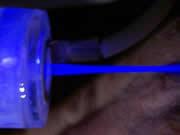 The mini light sabre could be useful in the dentist's office.© M. Laroussi/Old Dominion U
The mini light sabre could be useful in the dentist's office.© M. Laroussi/Old Dominion UThink of it as a miniature light sabre. Scientists have unveiled a 'plasma pencil', a handheld device that generates a thin plume of charged gas that can kill bacteria, and could one day etch away tumours without damaging surrounding tissue.
"It allows you to treat an area in a very precise way," says Mounir Laroussi, a physicist from the Old Dominion University in Norfolk, Virginia. Laroussi developed the 12-centimetre-long device with his colleague Xinpei Lu.
"It's small, portable, and can operate for at least 8 hours at a time," he adds. "Before this, our devices were large boxes that sat on a table."
Souped up
Plasmas are soups of charged ions and electrons. They are generated anywhere that atoms are stripped of their electrons: in solar flares or around lightning bolts, for example. Their violent birth means that the ions move very quickly, so plasmas have temperatures of thousands of degrees.
But Laroussi's device produces a room-temperature plasma that can be used safely on patients. "I have put my hand in the plume many times without anything happening," says Laroussi, who describes the device in the journal Applied Physics Letters1.
Although the beam has no effect on skin, previous experiments in Laroussi's lab have shown that Escherichia coli bacteria are killed when the plasma breaks open their cell walls. Now the team hopes to use the pencil to clean up the plaque-generating bugs that lie in the nooks and crannies of our mouth.
"It's very early in the project," cautions Wayne Hynes, a biologist at Old Dominion who works with Laroussi. "But there's no reason why it shouldn't kill mouth bacteria."
Cool for gas
The five-centimetre-long plasma plume is generated when a stream of helium gas containing a trace of oxygen passes between two high-voltage copper electrodes. Helium is very difficult to ionize, but the plume's oxygen molecules break into two highly reactive oxygen atoms, which then attack the bacteria.
Previous plasma plumes have come with all sorts of difficulties: they have been just a few millimetres long, at least tens of degrees warmer than room temperature, and sometimes carried the risk of electrical arcing.
The key to keeping the plasma pencil cool is its kilovolt electric field, which switches on and off thousands of times a second. This kicks the light electrons into high speeds, while the heavier ions are too weighty to be moved much by each zap of voltage. "It gives the electrons a lot of energy very quickly," says Laroussi.
Because electrons are so light, they impart very little heat energy to the material they crash into. "You get this plasma where the electrons are very hot, but the gas is very cool," explains plasma physicist Bill Graham of Queen's University, Belfast.
Deft touch
ADVERTISEMENT
Unlike conventional chemical treatments that kill bacteria, there are no residues to wash away afterwards. "It's essentially a chemical etching process where the reactive chemicals are being generated at the flick of a switch," says Graham.
The plasma pencil might eventually be used by doctors to kill off tumour cells, he adds. Surgical blades can often damage surrounding tissue, but the plasma pencil could be adapted to eat away at the cancer cells a few layers at a time.
Laroussi is now trying to understand at a biochemical level how the plasma breaks up bacteria, and how the plume could be tuned to attack specific types of cells.
